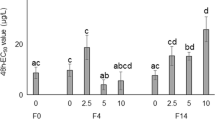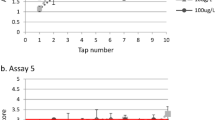Abstract
Globally, neonicotinoid contamination in aquatic environments, including estuarine areas, is a prevailing environmental concern. The estuarine resident marine crustacean sand shrimp Crangon uritai was previously found to have a higher tolerance to neonicotinoids than the marine crustaceans kuruma prawn Penaeus japonicus and mysid Americamysis bahia. Based on these findings, we aimed to explore the mechanisms underlying their differences in insecticide sensitivity. We hypothesized that differences in the structures of their nicotinic acetylcholine receptors (nAChRs) and/or the involvement of a metabolizing enzyme may confer sand shrimp resistance to neonicotinoids. No obvious differences were found in the amino acid residue (position 81) of the loop D region of the nAChR β-subunit among the three crustaceans. A synergistic toxicity bioassay was used to explore candidate metabolizing enzymes, esterase, glutathione S-transferase, and oxygenase. The three species were exposed to two neonicotinoids (acetamiprid and clothianidin) at concentrations equivalent to 1/15–1/10 of 96-h LC50 values and synergists (inhibitors of metabolizing enzyme) or combinations of both. Treatments with the oxygenase inhibitor and the neonicotinoids resulted in increased mortality in sand shrimps but not in kuruma prawns or mysids. Consequently, it was determined that oxygenase may explain the higher resistance of the sand shrimp to neonicotinoid insecticides.


Similar content being viewed by others
References
Bainy ACD (2000) Biochemical responses in penaeids caused by contaminants. Aquaculture 191:163–168
Bass C, Carvalho RA, Oliphant L, Puinean AM, Field LM, Nauen R, Williamson MS, Moores G, Gorman K (2011) Overexpression of a cytochrome P450 monooxygenase, CYP6ER1, is associated with resistance to imidacloprid in the brown planthopper, Nilaparvata lugens. Insect Mol Biol 20:763–773
Beadle K, Singh KS, Troczka BJ, Randall E, Zaworra M, Zimmer CT, Hayward A, Reid R, Kor L, Kohler M, Buer B, Nelson DR, Williamson MS, Davies TGE, Field LM, Nauen R, Bass C (2019) Genomic insights into neonicotinoid sensitivity in the solitary bee Osmia bicornis. PLoS Genet 15:e1007903
Brattsten LB, Berger DA, Dungan LB (1994) In vitro inhibition of midgut microsomal P450s from Spodoptera eridania caterpillars by demethylation inhibitor fungicides and plant growth regulators. Pestic Biochem Physiol 48:234–243
Erdmanis L, O’Reilly AO, Williamson MS, Field LM, Turberg A, Wallace BA (2012) Association of neonicotinoid insensitivity with a conserved residue in the loop D binding region of the tick nicotinic acetylcholine receptor. Biochemistry 51:4627–4629
Hano T, Ito K, Mochida K, Ohkubo N, Kono K, Onduka T, Ito M, Ichihashi H, Fujii K, Tanaka H (2015) Primary risk assessment of dimethyldithiocarbamate, a dithiocarbamate fungicide metabolite, based on their probabilistic concentrations in a coastal environment. Chemosphere 131:225–231
Hano T, Ohkubo N, Ito M, Onduka T, Ito K, Sakaji H (2017) Comparative toxicity of seven neonicotinoid insecticides and their two metabolites to juveniles of the marine crustacean kuruma prawn (Marsupenaeus japonicus). Jpn J Environ Tox 20:35–48
Hano T, Ito K, Ohkubo N, Sakaji H, Watanabe A, Takashima K, Sato T, Sugaya T, Matsuki K, Onduka T, Ito M, Somiya R, Mochida K (2019) Occurrence of neonicotinoids and fipronil in estuaries and their potential risks to aquatic invertebrates. Environ Pol 252:205–215
Iwasa T, Motoyama N, Ambrose JT, Roe RM (2004) Mechanism for the differential toxicity of neonicotinoid insecticides in the honey bee, Apis mellifera. Crop Prot 23:371–378
James MO, Boyle SM (1998) Cytochromes P450 in crustacea. Comp Biochem Physiol C Pharmacol Toxicol Endocrinol 121:157–172
Kurata H (1973) Variation and mechanisms of survival of the seeds shrimps sown on the tidelands. Reprinted from report of fisheries resources investigations by the scientists of the Fisheries Agency. Japn Govern (in Japanese with English abstract) 15:71–84
Manjon C, Troczka BJ, Zaworra M, Beadle K, Randall E, Hertlein G, Singh KS, Zimmer CT, Homem RA, Lueke B, Reid R, Kor L, Kohler M, Benting J, Williamson MS, Davies TGE, Field LM, Bass C, Nauen R (2018) Unravelling the molecular determinants of bee sensitivity to neonicotinoid insecticides. Curr Biol 28:1137–1143
Matsuda K, Kanaoka S, Akamatsu M, Sattelle DB (2009) Diverse actions and target-site selectivity of neonicotinoids: structural insights. Mol Pharmacol 76:1–10
Matsuda K, Ihara M, Sattelle DB (2020) Neonicotinoid insecticides: molecular targets, resistance, and toxicity. Annu Rev Pharmacol Toxicol 60:241–255
Morrissey CA, Mineau P, Devries JH, Sanchez-Bayo F, Liess M, Cavallaro MC, Liber K (2015) Neonicotinoid contamination of global surface waters and associated risk to aquatic invertebrates: a review. Environ Int 74:291–303
Sakaji H, Hano T, Watanabe A, Ito K, Ohkubo N, Matsuki K, Takahashi M (2019) Development of the “rake-sledge net” for efficiently sampling crustaceans in tide pools of tidal flats (in Japanese with English abstract). Cancer 28:e123–e128
Sánchez-Bayo F, Hyne RV (2014) Detection and analysis of neonicotinoids in river waters – development of a passive sampler for three commonly used insecticides. Chemosphere 99:143–151
Shimomura M, Okuda H, Matsuda K, Komai K, Akamatsu M, Sattelle DB (2002) Effects of mutations of a glutamine residue in loop D of the α7 nicotinic acetylcholine receptor on agonist profiles for neonicotinoid insecticides and related ligands. Br J Pharmacol 137:162–169
Shimomura M, Yokota M, Ihara M, Akamatsu M, Sattelle DB, Matsuda K (2006) Role in the selectivity of neonicotinoids of insect-specific basic residues in loop D of the nicotinic acetylcholine receptor agonist binding site. Mol Pharmacol 70:1255–1263
Toda S, Hirata K, Yamamoto A, Matsuura A (2017) Molecular diagnostics of the R81T mutation on the D-loop region of the β1 subunit of the nicotinic acetylcholine receptor gene conferring resistance to neonicotinoids in the cotton aphid, Aphis gossypii (Hemiptera: Aphididae). Appl Entomol Zool 52:147–151
Troczka BJ, Homem RA, Reid R, Beadle K, Kohler M, Zaworra M, Field LM, Williamson MS, Nauen R, Bass C, Davies TGE (2019) Identification and functional characterisation of a novel N-cyanoamidine neonicotinoid metabolising cytochrome P450, CYP9Q6, from the buff-tailed bumblebee Bombus terrestris. Insect Biochem Mol Biol 111:103171
Van Dijk TC, Van Staalduinen MA, Van der Sluijs JP (2013) Macro-invertebrate decline in surface water polluted with imidacloprid. PLoS ONE 8:e62374
Yamauchi S, Kiyosawa N, Ando Y, Watanabe K, Niino N, Ito K, Yamoto T, Manabe S, Sanbuissho A (2011) Hepatic transcriptome and proteome responses against diethyl maleate-induced glutathione depletion in the rat. Arch Toxicol 85:1045–1056
Zhao G, Rose RL, Hodgson E, Roe RM (1996) Biochemical mechanisms and diagnostic microassays for pyrethroid, carbamate, and organophosphate insecticide resistance/cross-resistance in the tobacco budworm, Heliothis virescens. Pestic Biochem Physiol 56:183–195
Acknowledgements
We are grateful to Ms. Miho Tanioka, Ms. Miki Shoda, Ms. Yumiko Takaba, Ms. Mika Momosaki, and Ms. Yuko Makimoto (National Research Institute of Fisheries and Environment of Inland Sea, Fisheries Research and Education Agency) for their technical assistance in conducting this investigation.
Funding
This work was supported by JSPS KAKENHI Grant Number 16H04962.
Author information
Authors and Affiliations
Corresponding author
Ethics declarations
Conflict of interest
The authors declare that they have no conflict of interest.
Additional information
Publisher's Note
Springer Nature remains neutral with regard to jurisdictional claims in published maps and institutional affiliations.
Rights and permissions
About this article
Cite this article
Hano, T., Ito, K., Ohkubo, N. et al. Involvement of oxygenase confers higher resistance to neonicotinoid insecticides in estuarine resident sand shrimp Crangon uritai than in kuruma prawn Penaeus japonicus and mysid Americamysis bahia. Fish Sci 86, 1079–1086 (2020). https://doi.org/10.1007/s12562-020-01467-5
Received:
Accepted:
Published:
Issue Date:
DOI: https://doi.org/10.1007/s12562-020-01467-5




